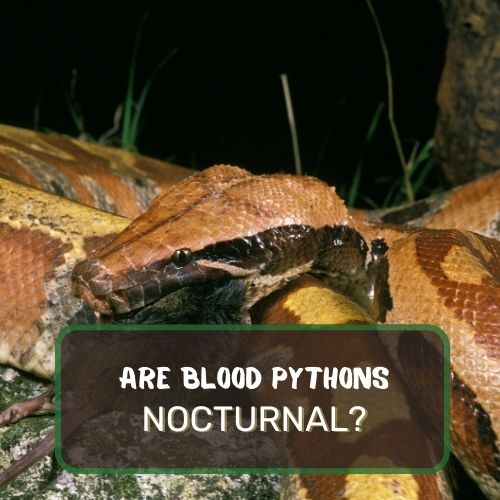
“Are ball pythons venomous?” is a question that has piqued the curiosity of many, from potential pet owners to wildlife enthusiasts.
In this article, we delve deep into the world of ball pythons, unraveling myths and presenting facts.
We’ll explore their nature, their hunting techniques, and what sets them apart from other snake species.
By examining their behavior, characteristics, and interactions with humans, we aim to provide a comprehensive answer to this intriguing question.
So, if you’ve ever pondered the venomous status of these captivating reptiles or are considering one as a pet, this article promises to equip you with the knowledge you seek.
Dive in and discover the fascinating realm of ball pythons!
Table of Contents
Are Ball Pythons Venomous?
Ball pythons are not venomous. Instead, they are constrictor snakes, which means they capture and subdue their prey by wrapping around it and squeezing tightly. This method of constriction restricts the prey’s ability to breathe, leading to its eventual demise. Ball pythons, like other pythons, lack venom glands and fangs.
They are popular pets due to their docile nature and the fact that they pose no venomous threat to their handlers. It’s essential, however, to handle them with care and respect, as with any animal, to ensure a positive and safe interaction.
The Truth About Ball Pythons

When you hear the word “python,” what’s the first thing that comes to mind? A massive, venomous snake lurking in the shadows, waiting to strike? Well, let’s debunk some myths and dive into the fascinating world of ball pythons.
Their Primary Defense Mechanisms
Ball pythons, like many creatures in the wild, have developed specific defense mechanisms to protect themselves. However, venom isn’t one of them.
Instead, when threatened, a ball python might curl into a tight ball, tucking its head inside its coils. This behavior is actually where they get their name from.
By doing this, they present a hard, scaly exterior to potential predators, making it difficult for them to harm the snake’s vulnerable parts.
Why They Are Considered Safe Pets
Ball pythons have gained immense popularity in the pet trade, and there’s a good reason for that. Their non-venomous nature, combined with their relatively docile temperament, makes them a favorite among reptile enthusiasts.
They’re not the type to lash out or bite without provocation. And even if they did, remember, no venom! This makes them a safer choice compared to other exotic pets.
However, as with any pet, it’s essential to understand their needs and provide them with a suitable environment.
Pythons as Constrictor Snakes
Now, let’s get into the nitty-gritty. Ball pythons are constrictors. This means they don’t rely on venom to subdue their prey. Instead, they use their powerful muscles.
When they spot a potential meal, they strike quickly, grabbing the prey with their sharp teeth.
The Method of Killing: Constriction Leading to Circulatory System Failure
Once the ball python has a firm grip on its prey, it wraps its body around it in tight coils. With each breath the prey takes, the python tightens its grip, making it harder and harder for the prey to breathe. This isn’t about suffocation, though.
The real cause of death is circulatory system failure. The pressure exerted by the python restricts blood flow, leading to a quick and efficient kill. It’s a testament to the ball python’s evolutionary prowess.
They’ve perfected a method of hunting that doesn’t rely on venom but is just as effective.
Ball pythons are fascinating creatures that have been misunderstood for far too long. They’re not the venomous monsters some might believe them to be. Instead, they’re efficient hunters and, for many, beloved pets.
So, the next time someone asks, “Are ball pythons venomous?”, you’ll have the perfect, well-informed answer!
Venomous vs. Non-Venomous Snakes

When it comes to the world of snakes, there’s a vast array of species, each with its unique characteristics. One of the primary distinctions we often hear about is whether a snake is venomous or non-venomous. But what does this really mean?
Basic Differences Between Venomous and Non-Venomous Snakes
The diverse world of snakes is a blend of both venomous and non-venomous species, each with its unique set of characteristics.
Understanding the basic differences between these two categories is crucial for both snake enthusiasts and the general public.
1. Venom Production: The most obvious distinction is the ability to produce venom. Venomous snakes have specialized glands that produce toxic substances. These toxins can vary in potency and effect, targeting different systems in their prey’s body, such as the nervous or circulatory system.
2. Delivery Mechanism: Venomous snakes are equipped with specialized fangs designed to deliver venom efficiently. These can be long, hinged fangs that fold back when not in use or shorter, fixed fangs.
3. Head Shape: While not a definitive indicator, many venomous snakes have a more triangular or diamond-shaped head due to the venom glands’ presence. In contrast, non-venomous snakes often have a more rounded head.
4. Pupil Shape: Some venomous snakes, like vipers, have vertical, slit-like pupils, while many non-venomous species possess round pupils. However, this isn’t a foolproof method, as there are exceptions.
5. Behavior: Venomous snakes might display warning behaviors when threatened, such as rattling their tails, hissing loudly, or adopting a striking posture. Non-venomous snakes might mimic these behaviors but lack the venomous bite.
Even though these differences provide a general guideline, it’s essential to approach all snakes with caution and respect. Misidentification can lead to dangerous situations, so when in doubt, it’s best to keep a safe distance.
How Venom is Used by Snakes
Venom isn’t just for hunting. For many snakes, it’s also a defense mechanism. When threatened, a venomous snake can deliver a bite, injecting its venom to deter potential predators.
The venom affects the nervous system, muscles, or blood of its victim, depending on the type.
Common Venomous Snakes and Their Characteristics
Venomous snakes have long fascinated and terrified humans with their lethal capabilities. While there are numerous venomous species worldwide, a few stand out due to their distinct features, venom potency, or widespread recognition.
Let’s delve into some of these notorious reptiles.
1. Rattlesnakes: Native to the Americas, rattlesnakes are easily identifiable by the unique rattle at the end of their tails. This rattle serves as a warning to potential threats. Their venom can cause tissue damage and can be fatal if not treated.

2. Cobras: Recognized by their iconic hood, cobras are found in parts of Asia and Africa. The King Cobra, the world’s longest venomous snake, can deliver a venomous bite potent enough to kill an elephant. Cobras can also “spit” venom as a defense mechanism.
3. Vipers: This group includes species like the European adder and the African puff adder. Vipers typically have a thick, heavy body and a triangular head. Their venom can cause severe pain, tissue necrosis, and sometimes death.
4. Black Mamba: Native to Africa, the Black Mamba is one of the world’s deadliest snakes. It’s incredibly fast and possesses a potent neurotoxic venom that can be fatal within hours if untreated.
5. Taipans: Found in Australia, taipans have some of the most toxic venom in the snake world. The Inland Taipan, often dubbed the “fierce snake,” has venom that’s 50 times more toxic than the Indian cobra.
In essence, while these venomous snakes are awe-inspiring, they command respect and caution. Understanding their characteristics can help in snake identification and ensuring safety.
Benefits of Having a Ball Python as a Pet

If you’re considering a reptilian companion, ball pythons are a top choice for many enthusiasts. Let’s delve into why they’re such a popular pick.
Their Low Maintenance Nature
Ball pythons are relatively easy to care for. They don’t require daily feeding, and their habitat needs are straightforward. A warm, secure enclosure with the right humidity level is all they need to thrive.
The Joy of Observing Their Unique Behaviors
Watching a ball python explore its environment, curl into its namesake ball, or even just bask under a heat lamp can be incredibly soothing. Their slow, deliberate movements have a calming effect, making them a joy to observe.
The Educational Value for Kids and Adults Alike
Owning a ball python can be a fantastic educational experience. It offers a hands-on way to learn about reptile biology, behavior, and the importance of conservation.
For kids, it instills a sense of responsibility and a deeper appreciation for nature.
Their Easygoing Nature and Diverse Color Variations
Ball pythons are known for their docile temperament. They’re not prone to aggressive behavior, making them safe pets even for families with children.
Additionally, with the myriad of color morphs available, you can choose a snake that fits your aesthetic preference, from bright yellows to deep blacks and everything in between.
Safety Precautions with Ball Pythons
Ball pythons, with their docile nature and captivating presence, have become a favorite among reptile enthusiasts. However, like any pet, it’s essential to approach them with respect and knowledge.

Ensuring safety for both the handler and the snake is paramount. Let’s delve into some safety precautions to consider.
Handling Tips for New and Experienced Owners
Whether you’re a newbie or a seasoned ball python owner, handling your snake correctly is crucial. For starters, always approach your python calmly and confidently. Quick or jerky movements can startle them.
When picking up your python, gently slide your hand under its mid-body, supporting as much of its weight as possible. Avoid grabbing its tail or head.
For new snakes or those not used to handling, limit the handling time initially and gradually increase as they become more accustomed.
What to Do if Bitten (Even Though They’re Not Venomous!)
While ball pythons are not venomous, any animal with teeth can bite if threatened or scared. If bitten, remain calm. Panicking or pulling away can cause more harm.
Gently uncoil the snake if it latches on, and once free, wash the bite area with warm water and soap. Even though the bite might not be venomous, it’s essential to prevent any potential infections.
Monitor the area for any signs of swelling or redness and consult a doctor if needed.
Ensuring the Safety of Both the Snake and the Handler
Your python’s safety is just as important as yours. Ensure that their habitat is secure to prevent escapes. When handling, be mindful of their body language. If they seem stressed or agitated, it might be best to give them some space.
Also, be cautious about introducing them to other pets, as this can be a source of stress or danger for both parties.
While ball pythons are relatively easy-going, understanding their needs and ensuring safety for everyone involved will make the experience more enjoyable and fulfilling.
Remember, mutual respect is the key to a harmonious relationship with these fascinating creatures.

Wrapping Up
In your journey through this article, you’ve unraveled the mysteries surrounding ball pythons, particularly the burning question: “Are ball pythons venomous?”.
You’ve delved into their unique behaviors, understood the distinctions between venomous and non-venomous snakes, and even explored some of the world’s most notorious venomous serpents.
It’s evident that ball pythons, with their docile nature and non-venomous status, stand out as fascinating creatures, both in the wild and as potential pets.
As you move forward, armed with this newfound knowledge, remember that understanding and respect are key to any interaction with the natural world.
Whether you’re considering a ball python as a companion or simply satiating your curiosity, you’re now better equipped to appreciate these remarkable reptiles.
Keep nurturing your thirst for knowledge, and always remember: the world of nature holds endless wonders, waiting for you to discover. Keep exploring, and let your learnings guide your path!
FAQ
Are ball pythons poisonous to humans?
No, ball pythons are not poisonous to humans. In fact, they are non-venomous constrictors. This means they don’t produce venom and rely on constriction to subdue their prey. They pose no venomous threat to their handlers or owners.
Are ball python bites painful?
While a bite from a ball python might be surprising and can cause discomfort, it’s generally not severely painful. Remember, they don’t have venom, so there’s no burning sensation like you’d expect from a venomous snake. However, like any animal bite, it can cause skin breakage, and there might be some minor bleeding.
Is it safe to touch a ball python?
Absolutely! Ball pythons are known for their docile nature, making them one of the most popular pet snakes. As long as you handle them gently and respectfully, touching them is safe. However, always wash your hands after handling any reptile to prevent potential transmission of bacteria like salmonella.
Do ball pythons have fangs?
Ball pythons do not have long, hinged fangs like venomous snakes. Instead, they have small, sharp teeth that curve backward. These teeth are designed to grip and hold onto their prey, ensuring it doesn’t escape as the snake begins the constriction process.




0 Comments